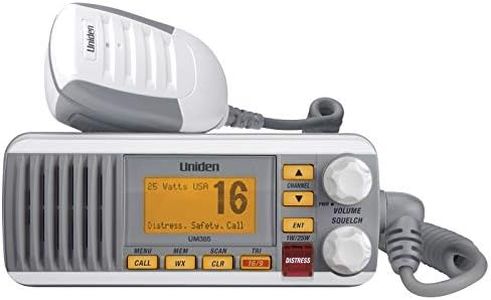We Use CookiesWe use cookies to enhance the security, performance,
functionality and for analytical and promotional activities. By continuing to browse this site you
are agreeing to our privacy policy
5 Best Marine Vhf Radios
From leading brands and best sellers available on the web.Buying Guide for the Best Marine Vhf Radios
Choosing a marine VHF radio is an important decision for anyone spending time on the water, whether for boating, fishing, or sailing. These radios serve as vital tools for communication, safety, and coordinating with marinas or other vessels. To make the right choice, it's essential to understand the main features and specifications so you can select a model that fits your specific boating activities and ensures reliable performance during emergencies and daily use alike.Power OutputPower output in marine VHF radios refers to how strong the radio's signal is, generally measured in watts. This is important because higher power lets your messages travel farther, which can be vital for communicating at sea. Most handhelds offer 1 to 6 watts and fixed-mount units often go up to 25 watts. If you only boat on lakes or rivers near shore, a lower power level might be sufficient. For offshore or open-water use, more power is better for longer-range communication and increased safety.
Fixed vs. HandheldThis spec tells you whether the radio is portable (handheld) or installed in a specific spot on your boat (fixed-mount). Handheld radios are convenient, easy to carry, and often water-resistant, making them good for small boats or as back-ups. Fixed-mount radios usually offer more power and larger antennas, leading to greater range and clearer communication—ideal for larger boats or serious offshore trips. Consider what type of boating you do most; portability is best for flexibility, while fixed-mount is best for performance and range.
DSC CapabilityDigital Selective Calling (DSC) is a feature that allows you to send automated distress calls with your location at the push of a button. This can be a lifesaver in emergencies, as it quickly alerts nearby vessels and rescue services. Radios with DSC require you to register for an MMSI number, which identifies your boat. If you spend time in areas where help might be far away, DSC is highly recommended for peace of mind, but if you only do short trips in busy waters, it may not be as critical.
Waterproof and Floating DesignThis describes how well the radio can handle being in wet conditions or submersion. Radios rated as waterproof can withstand splashes or short drops in water, while floating models are designed not to sink if dropped overboard. For activities where you’re likely to get wet—like kayaking, sailing, or fishing—look for radios with solid waterproof ratings and floating features, as this keeps them usable and easy to retrieve in rough conditions.
Battery LifeBattery life is a measure of how long a radio will operate before it needs recharging or new batteries. Longer battery life is essential if you’re planning longer trips, spending many hours on the water, or using the radio in an emergency situation. Some radios also offer options for both rechargeable and standard batteries for flexibility. If you’re mostly out for short outings, battery life might not be as crucial, but for daylong or multi-day trips, pick a model with extended battery performance.
Channel Availability and Weather AlertsMarine VHF radios use channels assigned for specific purposes, including distress and safety. Many modern radios also offer weather alert functions to keep you updated on changing conditions. It’s important because access to weather alerts can prepare you for sudden changes and designated channels ensure you can always reach help or communicate effectively with others. If you boat in areas with unpredictable weather or where traffic control is needed, make sure the radio covers the necessary international or local channels and has reliable weather alert capability.
Display and ControlsThe display and controls on a VHF radio impact how easy it is to use the device, especially in awkward conditions. A clear, well-lit display helps you read information quickly, and simple, intuitive controls mean less fuss when time matters. If you boat at night or in tough weather, opt for larger, backlit displays and buttons you can operate with gloves. For casual, daytime users in calm waters, basic controls and displays may suffice.





